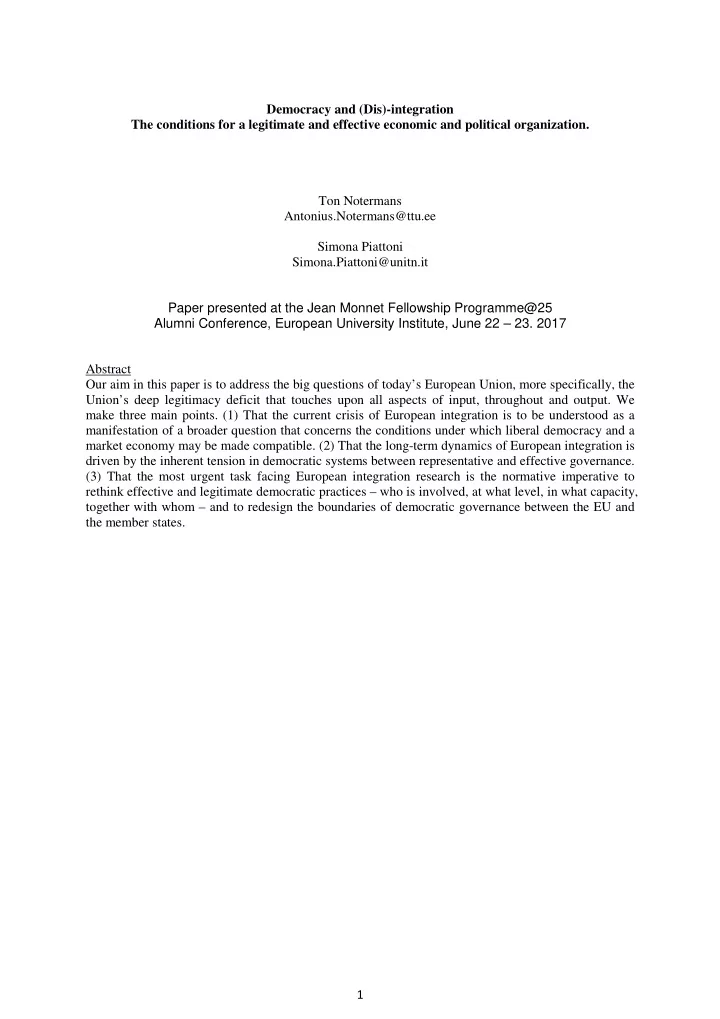

Democracy and (Dis)-integration The conditions for a legitimate and effective economic and political organization. Ton Notermans Antonius.Notermans@ttu.ee Simona Piattoni Simona.Piattoni@unitn.it Paper presented at the Jean Monnet Fellowship Programme@25 Alumni Conference, European University Institute, June 22 – 23. 2017 Abstract Our aim in this paper is to address the big questions of today’s European Union, more specifically, the Union’s deep legitimacy deficit that touches upon all aspects of input, throughout and output. We make three main points. (1) That the current crisis of European integration is to be understood as a manifestation of a broader question that concerns the conditions under which liberal democracy and a market economy may be made compatible. (2) That the long-term dynamics of European integration is driven by the inherent tension in democratic systems between representative and effective governance. (3) That the most urgent task facing European integration research is the normative imperative to rethink effective and legitimate democratic practices – who is involved, at what level, in what capacity, together with whom – and to redesign the boundaries of democratic governance between the EU and the member states. 1
Table of Contents 1 Introduction ..................................................................................................................................... 3 2 Integration Theory and the Second Rescue of the Nation State ...................................................... 4 3 Representative versus Effective Governance .................................................................................. 6 4 A Short Version of the Long History of European Integration ....................................................... 8 4.1 Pathologies of Neo-Liberalism ................................................................................................ 8 4.2 The Rise and decline of the Interwar Gold Standard ............................................................... 9 4.3 Neoliberalism and the Second European Rescue of the Nation State ................................... 13 5 Rethinking Europe ......................................................................................................................... 17 6 References ..................................................................................................................................... 23 Table of Tables Table 1: Introduction of General Suffrage ............................................................................................ 10 Table 2: Total Household Debt as % of Net disposable income ........................................................... 18 Table 3: Voter Turnout, Parliamentary Elections (%) ........................................................................... 19 Table 4: European Citizen's Main Concerns: The Three Most Frequently Mentioned issues .............. 20 2
1 Introduction 1 The Eurozone crisis placed a problem on the political agenda that had seemed solved since the post- 1945 period, namely the compatibility of capitalism and democracy. The governance of the common currency, from the start, was based on the conviction that only a politically independent central bank would safeguard stability. Since the onset of the crisis, also democratic governance of fiscal policy is considered a potential threat to stability as the Fiscal Compact seeks to anchor a balanced budget rule in the constitution of each member state. Restoring market confidence in the Euro required that, as Chancellor Merkel once put it, democracy be market conforming. 2 The conflict between democracy and the requirements of the common currency became particularity acute in the countries subjected to the conditionality of the so-called Troika. Since the Troika concluded that flexible labour and product markets in combination with budget surpluses were required to make their membership in the common currency viable, governments in the GIIPS countries found themselves engaged in policies of cutting wages, undermining labour’s bargaining power and dismantling welfare arrangements against the wishes of a majority of their electorate. This conviction that political democracy is inimical to the requirements of a stable currency is not new to Europe. While several scholars have pointed to striking economic similarities between the current crisis and the Great Depression (Eichengreen 2015; Eichengreen & Temin 2010; O’Rourke & Taylor 2013), political dynamics also are increasingly reminiscent of the interwar period; in particular increasing polarisation and fragmentation of the party system and the rise of extremist and populist politics. Though all countries had to grapple with the issue of how to reconcile the demands of the Gold Standard and democracy, tensions also then were most acute in the indebted periphery. As the primacy of politics over fiscal and monetary policy sparked massive inflation, and hyperinflation in Austria, Germany, Hungary and Poland, the League of Nations set out to return the periphery to monetary stability by means of resurrecting the Gold Standard. This highly interventionist programme frequently bought financial stability at the price of democracy (Clavin 2013: 25 – 33; Polanyi 2001: 241). The globalisation backlash provoked by the Great Depression eventually removed the tension between democracy and the market by establishing the primacy of politics over the currency. In Western Europe, a highly successful, and in its nature social-democratic, socially inclusive political arrangement was established (Berman 2006; Ruggie 1982). From now, international financial transactions, as well as trade could be interfered with when in conflict with the requirements of internal balance while, if necessary, the parity would be adjusted to wage cost developments rather than the other way round. The result was the so-called Trente Glorieuses, the only monetary and financial regime that has managed to combine high growth, monetary and financial stability, low unemployment and social inclusion. The early form of European integration dovetailed with this ‘embedded liberalism’ as it was designed to help the member states cement the new social contract: a ‘European rescue of the nation state’ in Alan Milward’s (2000) felicitous words. However, since the 1980s European integration took a distinct neo-liberal turn as it increasingly reduced the policy tools available to national governments while seeking to enforce the primacy of the economy (Chiti, Menéndez & Teixeira 2012; Schulz- Forberg & Stråth 2010). The Single European Act (SEA), Monetary Union (EMU) and the Single Market in Financial Services (SMFS) were the most important waymarks along this road. Yet, as in the interwar period, this liberal solution proved unstable. The combination of depoliticisation and the economic pathologies of heightened volatility, high unemployment and increasing income inequality, similarly to the ‘double movement’ documented by Polanyi (2001), provoked an anti-globalisation / Europeanisation backlash. This historical sequence raises two question. How did the EU stumble into 1 We would like to thank the Director of the Robert Schuman Centre for Advanced Research, Brigid Laffan, the panel conveners, Lars-Erik Cederman and Douglas Webber, and the RSCAS staff for organizing this conference. We would like to thank particularly Lars-Erik Cederman for his insightful comments. 2 (http://www.faz.net/aktuell/politik/harte-bretter/marktkonforme-demokratie-oder-demokratiekonformer-markt- 11712359.html. 3
Recommend
More recommend